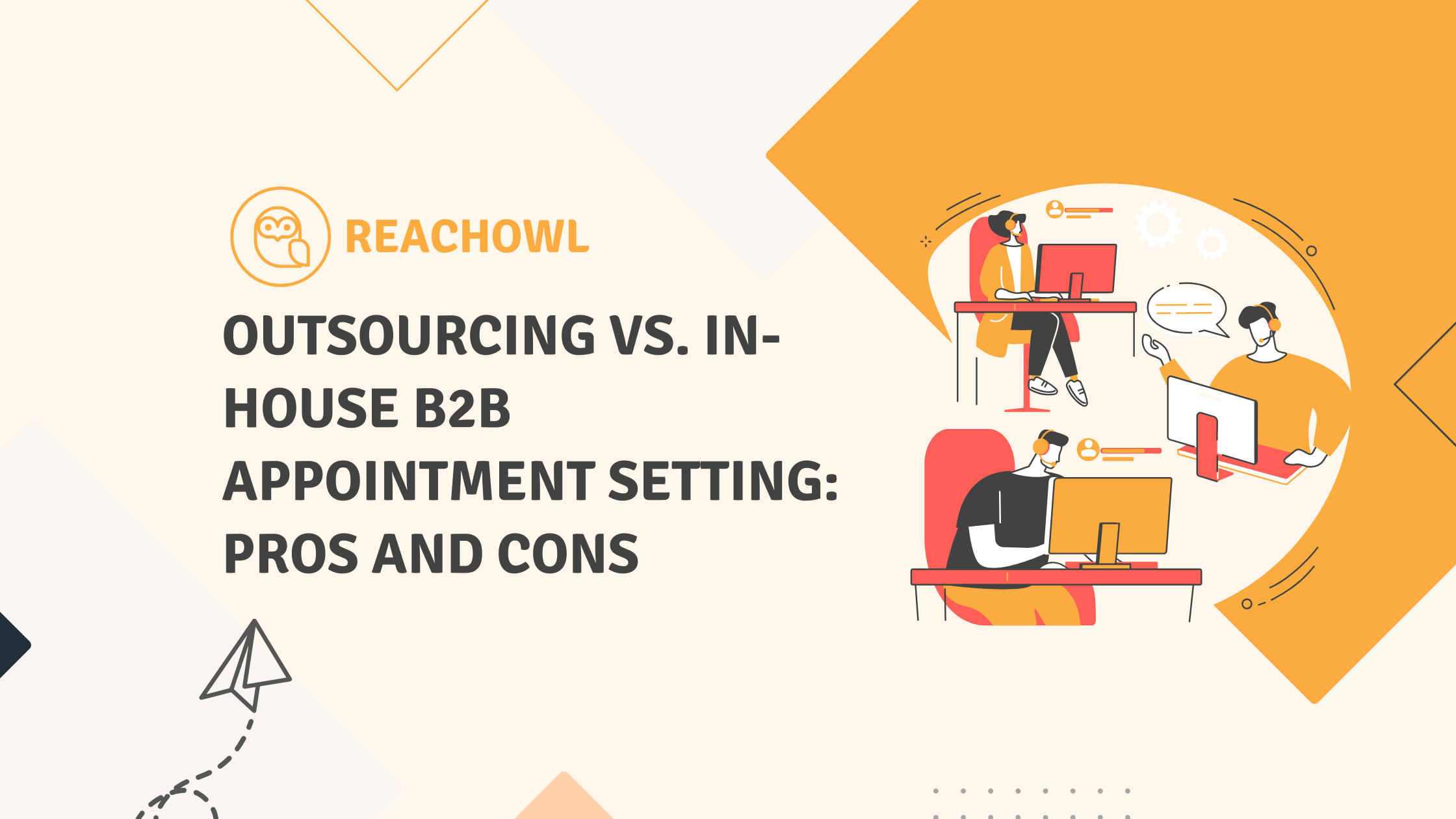B2B appointment setting is crucial for driving business growth by arranging meetings with potential clients. Companies can either outsource this task to specialized agencies or manage it in-house.
In this blog, we will explore the pros and cons of both approaches to help you make an informed decision for your organization.
Table of Contents
ToggleWhat is the importance of effective appointment setting for businesses?
Scheduling meetings with future clients is a vital element of B2B sales and marketing, providing opportunities to discuss products, services, or business solutions. Effective appointment setting is a direct contributor to sales revenue and overall business growth.
Outsourcing B2B Appointment Setting
Outsourcing involves hiring third-party agencies to manage the appointment scheduling process.
Here are some advantages and disadvantages of outsourcing:
Pros:
1. Expertise and Experience:
Professional agencies specialize in appointment setting, employing trained teams skilled at overcoming gatekeepers and handling objections. By outsourcing, you gain access to their expertise without investing in training an internal team.
2. Scalability:
Outsourcing allows quick scalability of appointment setting efforts, allowing for adjustments in resources to accommodate business expansion or increased leads. This flexibility makes sure that your appointment setting campaign can effectively keep up with your B2B sales growth.
3. Cost Savings:
Outsourcing is often more cost-effective than managing an in-house team. It eliminates the need for expenses like employee salaries, training, and software infrastructure.
4. Focus On Core Competencies:
By outsourcing appointment setting, your internal team can focus on their core competencies, such as product development or closing sales, enhancing overall productivity.
Cons:
1. Lack of Control:
With outsourcing, you lose some control over the appointment process. Agencies determine how appointments are set and may not always align with your internal strategies, potentially impacting lead quality.
2. Communication Challenges:
Communication is key to successful appointment setting. Working with an outsourced marketing director or agency introduces an additional layer of communication, which can sometimes result in miscommunication or delays. It is important to establish clear lines of communication and ensure effective collaboration to reduce these challenges.
3. Brand Consistency:
Outsourced teams may not have a deep understanding of your brand, which could lead to inconsistencies in messaging during client interactions. Maintaining brand alignment is critical to preserving your company’s market perception.
Boost Your Outreach with ReachOWL Cloud!
Run campaigns seamlessly in the background—no browser needed.
In-House B2B Appointment Setting
In-house B2B appointment setting involves building and managing an internal team dedicated to setting appointments.
Let’s study the advantages and disadvantages of this approach:
Pros:
1. Full Control:
An in-house appointment setting team allows you full control over the entire process, aligning the structure of the appointment setting strategy with your business objectives while reflecting your brand messaging and values. You can provide direct feedback and make real-time adjustments as needed.
2. Knowledge of the Business:
Internal appointment setters have a deeper understanding of your products, services, and industry, allowing them to engage in more meaningful conversations with future clients, address specific pain points, and position your offerings effectively. In-house teams can also offer valuable insights and feedback to other departments within the organization.
3. Immediate Feedback Loop:
In-house teams benefit from direct access to your sales and marketing departments, creating a faster feedback loop. This feedback loop allows for circular improvements in the appointment-setting process, leading to more effective campaigns over time.
Cons:
1. Resource Intensive:
Setting up an in-house appointment setting team requires substantial investment in hiring, training, and retaining employees, as well as providing the required infrastructure, software, and tools for their work. These costs can be important, especially for smaller businesses with limited resources.
2. Limited Scalability:
Unlike outsourced agencies, in-house teams may face challenges when scaling up quickly to handle increased demand or accommodate growth. The process of training and hiring new employees can take time, which may result in missed opportunities or overburdened staff during periods of high demand.
3. Specialized Skill Set:
Appointment setting requires specific skills, such as strong communication, persuasion, and relationship-building abilities. Finding and retaining individuals with the right skill set can be challenging, especially in competitive job markets. Additionally, managing an in-house job involves ongoing training and development to address this involvement.
Factors to Consider when Choosing between Outsourcing and In-house
1. Business goals and priorities:
Consider your business objectives and how appointment setting takes place with them. Evaluate whether you require specialized expertise or if it is a core ability that should be managed in-house.
2. Budget and cost considerations:
Evaluate the financial resources available for appointment setting and bookkeeping. Compare the costs of outsourcing with the expenses involved with building an in-house team, such as salaries, benefits, training, and infrastructure.
3. Level of control and involvement desired:
Assess the level of control you want over the appointment setting process. If maintaining close oversight and direct involvement is key, an in-house approach may be more suitable. However, if you prefer to focus on core competencies and delegate appointment setting, outsourcing can offer convenience.
4. Availability of internal resources and expertise:
Evaluate your organization’s existing resources and expertise. Determine if you have the necessary personnel, skills, and technology to handle appointment setting effectively internally. If not, outsourcing can provide access to specialized resources and expertise.
Conclusion
Choosing between outsourcing and in-house B2B appointment setting depends on factors such as budget, control, scalability, and expertise. Outsourcing provides flexibility, cost savings, and access to specialized knowledge but may introduce challenges with control and communication. In-house appointment setting offers greater control and brand consistency but requires a significant investment in resources.
Ultimately, the best decision for your business will depend on your unique needs and goals. Some companies may find a hybrid approach—combining in-house and outsourced efforts—works best. Regardless of your choice, effective appointment setting remains a critical strategy for generating quality leads and driving business growth.

